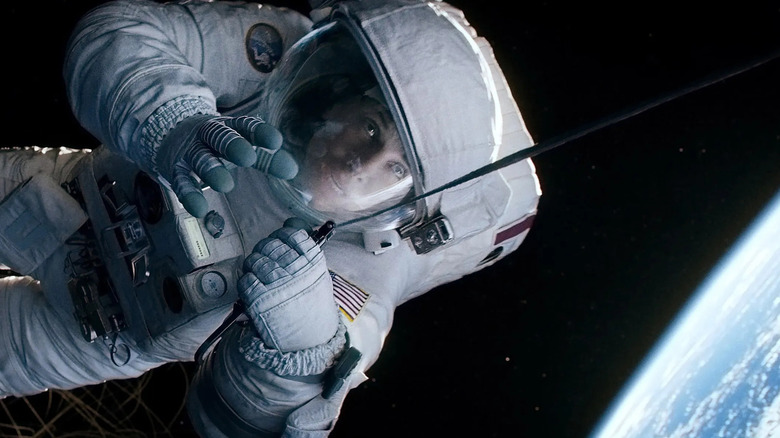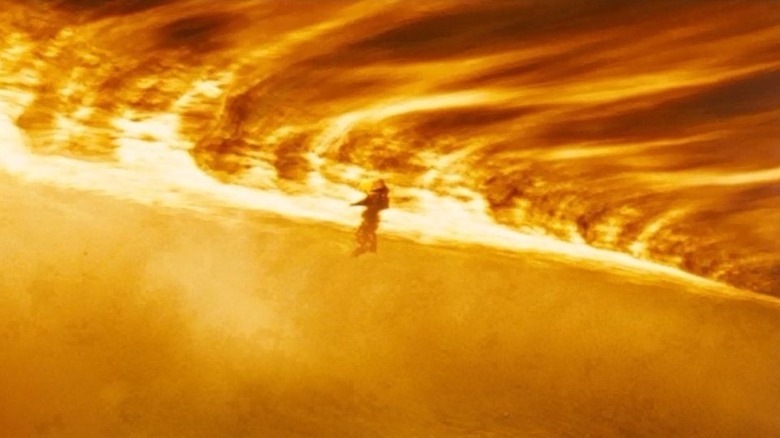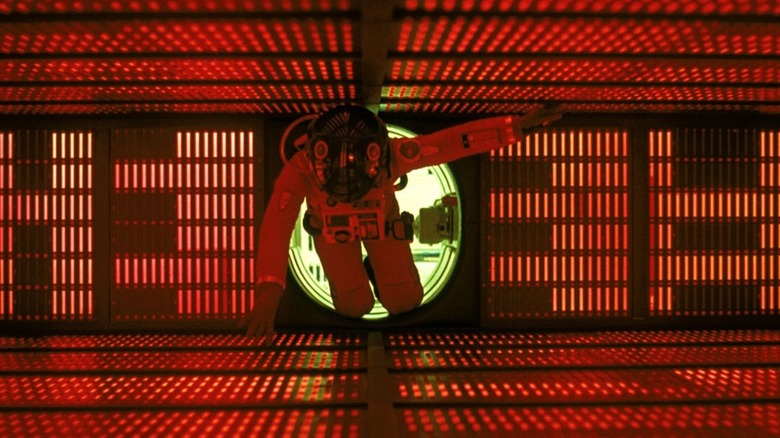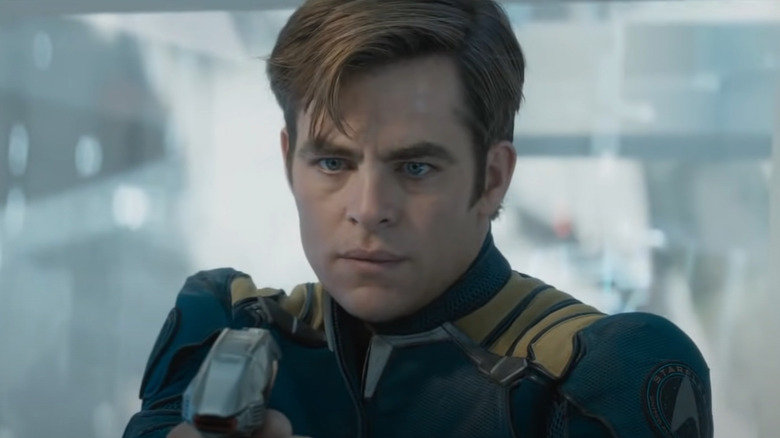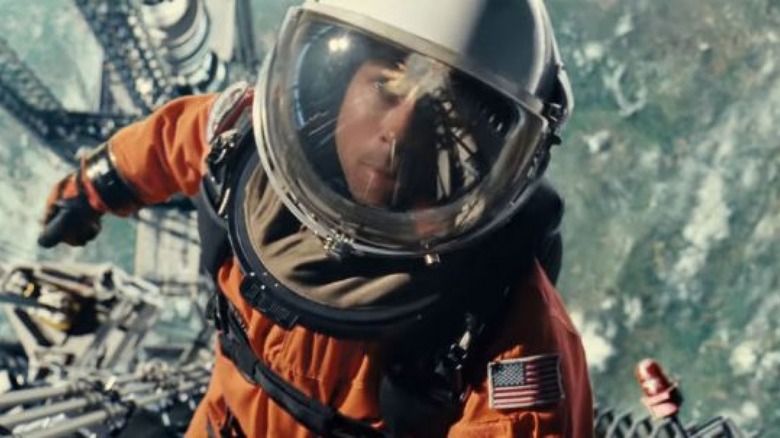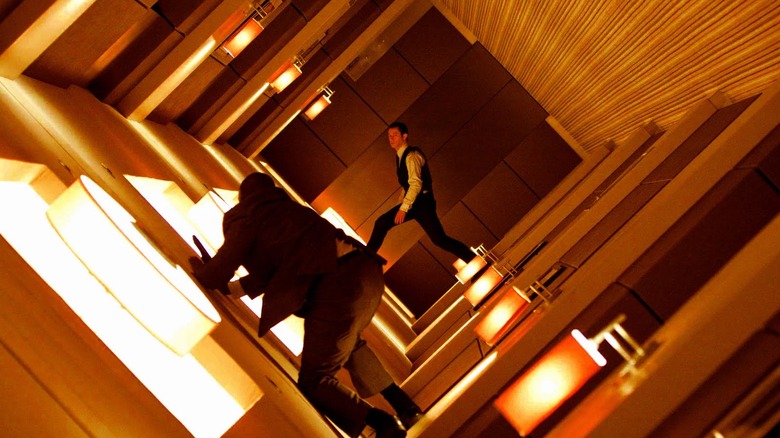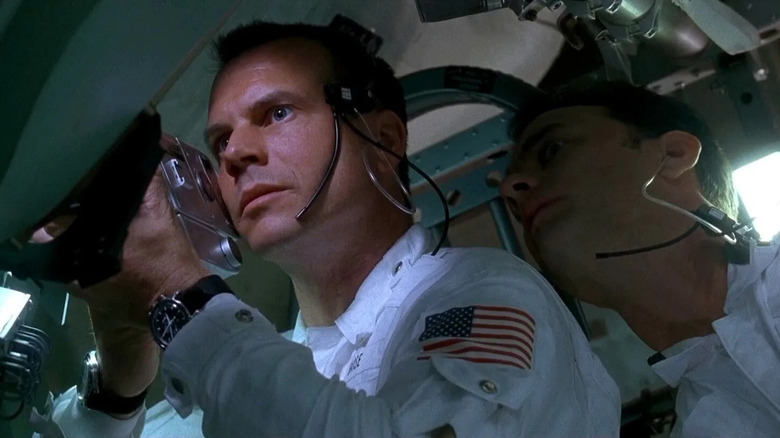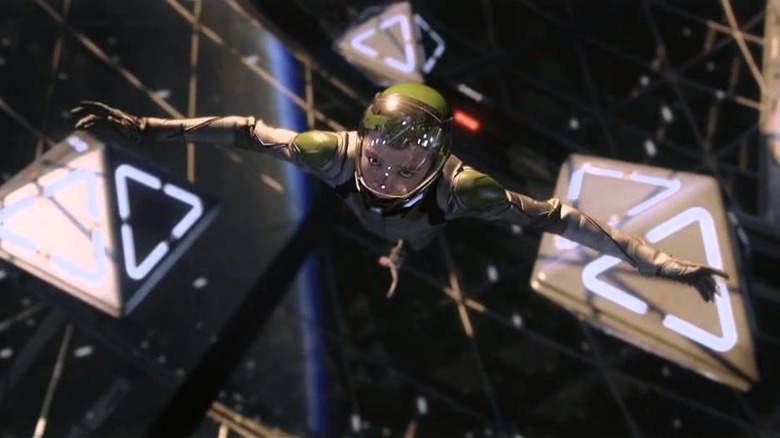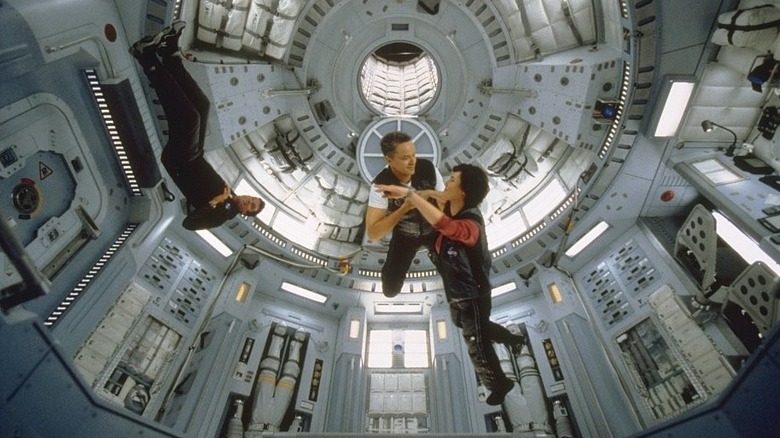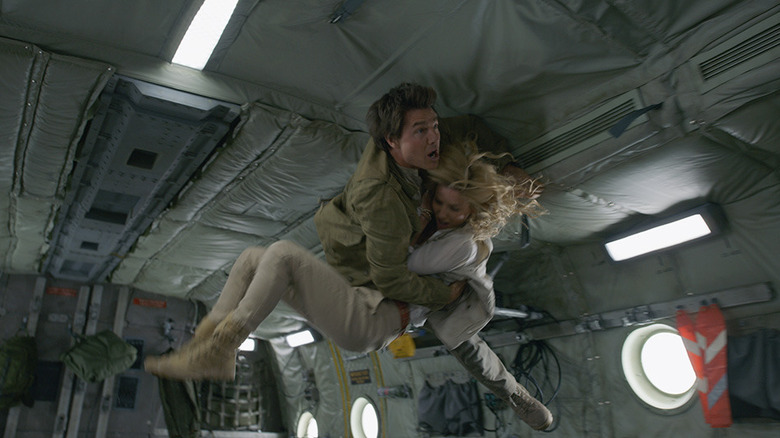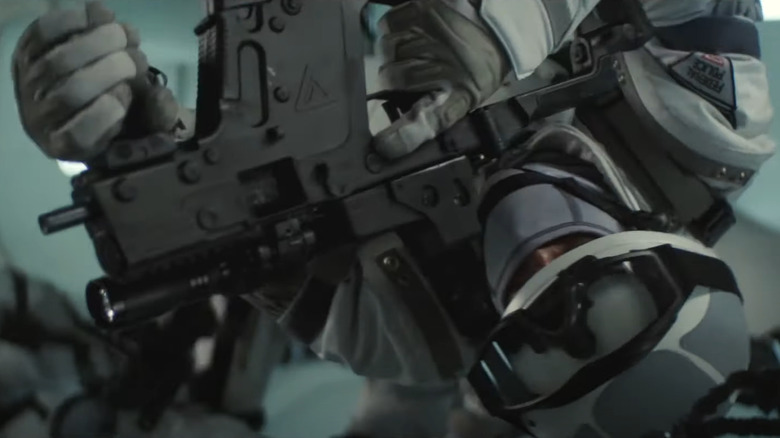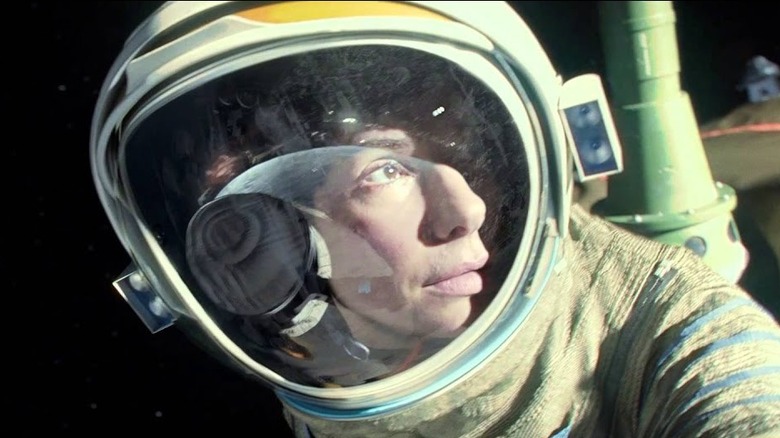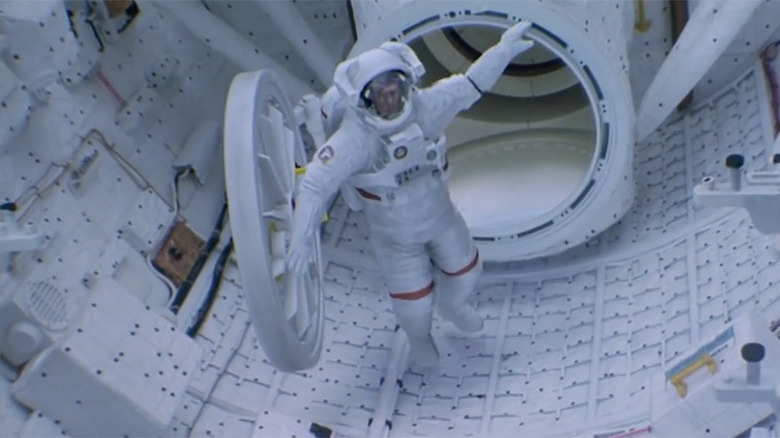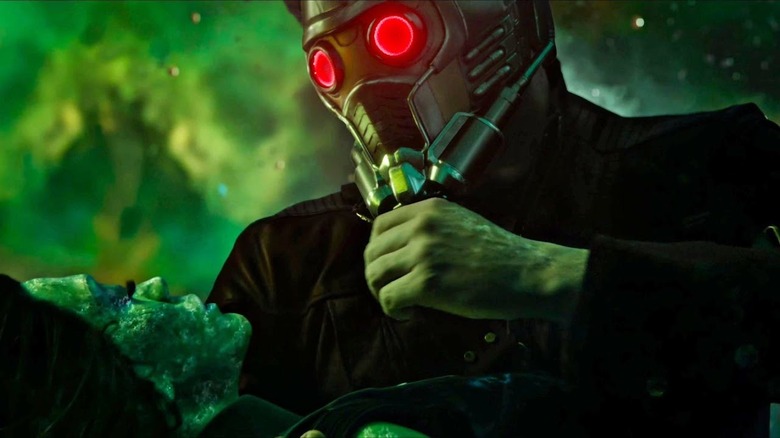13 Best Zero Gravity Scenes In Movie History
Some of the earliest films in movie history took audiences into outer space — such as the 1902 silent classic "A Trip to the Moon." Capturing what it's really like in space has long been a fascination of filmmakers. But it wasn't until the advent of more advanced special effects techniques that audiences were finally able to experience the magic and mystery of the cosmos, and nowhere is this more resonant than when portraying the strangeness of zero gravity.
Whether captured through clever camera tricks, hidden wires, CGI, or even the rare movie filmed in actual zero-g, these scenes can mystify moviegoers while providing a rich backdrop for a story's most moving, heartfelt moments. In fact, some of the best filmmakers of all time have used the weightlessness of zero gravity to help explore characters and amplify drama, from Danny Boyle Stanley Kubrick.
Whether they awed audiences with jaw-dropping effects, moved us emotionally while weightless, or were just plain cool, these gravity-defying scenes are worth writing home about. So get in your space suit and check your oxygen levels, because we're going on a spacewalk to explore the best zero gravity scenes in movie history.
Kaneda's sacrifice in Sunshine
"Sunshine" is set in a dystopian near-future where the inexplicable dimming of Earth's sun has led to global devastation, and if something isn't done, all life on Earth may be wiped out. A group of scientists and astronauts embark on a mission to detonate a stellar bomb aboard a spacecraft called Icarus II that could reignite the star. But the discovery of Icarus I — an earlier mission that failed under mysterious circumstances — threatens to derail their quest to save humanity.
A mix of horror, thriller, and science fiction, "Sunshine" features a sterling ensemble cast that included Chris Evans, Michelle Yeoh, Cillian Murphy, and Hiroyuki Sanada, and it's the latter who gets one of the film's most powerful moments. It happens in zero gravity, when physicist Robert Capa (Murphy) and ship's captain Kaneda (Sanada) must spacewalk on the outside of the Icarus II's heat shield to repair a series of malfunctioning protective panels before the sun's heat and radiation obliterate them both.
But with the final panel too far out. Kaneda is forced to sacrifice himself to save the mission. Knowing he won't make it back before he's enveloped by the sun's devastating energy, he chooses to face death head-on. As the emotional musical score crescendos, the floated, doomed form of Kaneda is consumed by fire all while the ship's doctor Searle — obsessed with viewing the Sun himself — desperately asks him to describe what he sees.
Dave battles HAL9000 in 2001: A Space Odyssey
Perhaps the most important science fiction film in the history of cinema, "2001: A Space Odyssey" redefined the genre amid the excitement of the very real space race in the late 1960s. Written by sci-fi luminary Arthur C. Clarke, the story kicks off with the discovery of a strange monolith on Jupiter, and a crew led by Dr. Dave Bowman is sent to uncover its secrets. But when their ship's artificially intelligent computer HAL 9000 begins acting strangely, Bowman must fight back against the ship itself to stay alive.
Thanks to groundbreaking special effects, "2001" dazzled audiences with several zero gravity sequences the likes of which audiences had never seen. From the rotating run at the film's start to balletic space walks and beyond, the film raised the bar for how movies portrayed space exploration. And one of the most riveting scenes takes place in zero gravity, inside the ship's computer core, when after HAL 9000 has already killed the rest of the crew, Bowman must race against time to shut down its programming.
Floating through a vast storage room that serves as the heart of HAL's internal workings, Bowman must delicately maneuver his way through the system and remove a series of computer chips by hand, all while his A.I. enemy mocks him, taunts him, and then finally begs for his mercy as he slowly dies.
Kirk and Krall duel in Star Trek Beyond
The "Star Trek" franchise was rebooted in 2009 by J.J. Abrams, and got its third entry in 2016, "Star Trek Beyond." Here, the crew of the USS Enterprise find themselves marooned in a distant world and under threat from a deadly new foe named Krall (Idris Elba).
Invading the massive city-sized starbase Yorktown that is home to thousands, Krall means to detonate a deadly bio-weapon, and only Captain Kirk (Chris Pine) can stop him. In one of the most remarkable sequences of the trilogy, Kirk and Krall battle for control of the weapon within the heart of the starbase's ventilation system, which just so happens to be situated at a neutral point in its gravitational field, where there is no up or down. In a duel to the death, Kirk must stop Krall from getting his hands on the device and killing everyone aboard the starbase, while swings in gravity pull them in every possible direction.
In the eye-popping, mesmerizing action scene, Kirk manages to outwit the villain and save the day, but not before the pull of gravity has its way with them both.
Brad Pitt lets go in Ad Astra
A film that seems heavily influenced by "2001: A Space Odyssey," the 2019 psychological sci-fi drama "Ad Astra" is set decades after a mission to deep space to learn what happened to a previous mission that was sent to investigate signs of alien life. Unfortunately, the mission and its commander H. Clifford McBride (Tommy Lee Jones) were never heard from again, and now decades later, problems on Earth can be traced to McBride's last known coordinates.
Setting out to Mars to attempt communication, McBride's son Roy (Brad Pitt) hopes to solve the planetary crisis and find his long-thought-lost father. But the film is as much about Roy's relationship with his father as it is about the threat to planet Earth and the mission to end it, and what makes "Ad Astra" stand out is a zero gravity moment when father and son must make a tearful goodbye on a doomed space walk.
Together after decades apart, Roy is stunned to learn that his father doesn't want to return home with him. But getting the information he needs to save the planet from destruction, Roy desperately and silently pleads with his father to come back with him. With no music, and almost no sound, it's a heartbreaking zero gravity moment as Cliff calmly tells his son: "Let me go." Roy does and watches helplessly as his father drifts into the void of space.
The hallway fight in Inception
Most audiences probably don't think of Christopher Nolan as a science fiction director, but step back and you'll see he's helmed some of the best sci-fi films of the last decade. This includes the outer space drama "Interstellar" and the time-twisted "Tenet," but his best is almost certainly the mind-bending "Inception." Starring Leonardo DiCaprio, Tom Hardy, Elliot Page, and Joseph Gordon-Levitt, the film centers on a group of mercenary dream-hunters who can enter people's subconscious and steal information. But this time, they're tasked with entering the dreams of a powerful tycoon to implant an idea rather than take one.
In what is easily the film's most unforgettable scene, set within the confines of a dreamscape where the laws of physics don't always apply, mind thief Arthur (Gordon-Levitt) is confronted by security agents in a hotel hallway. But in the real world, Arthur is actually asleep in the back of a van, and when the vehicle gets involved in a dangerous chase and tumbles off the roadway, the hotel in his mind begins to tumble as well.
Now, with gravity pulling him from floor to ceiling to wall to back again, Arthur must battle the enemy agents in his mind, all while his life in the real world hangs in the balance too. With jaw-dropping practical effects that required the construction of a rotating hallway, it's also one of the most impressive achievements in a Christopher Nolan film.
Crisis aboard Apollo 13
Directed by Ron Howard and starring Tom Hanks, Bill Paxton, Kevin Bacon, Ed Harris, and Gary Sinise, 1995's "Apollo 13" dramatized the remarkable true story of a NASA mission gone wrong. Aboard a tiny three-person capsule, astronauts Jim Lovell, Jack Swigert, and Fred Haise are forced into a desperate fight for their lives when a piece of their module explodes. With barely any power and only scant communication with Earth, NASA engineers must find a way to bring them home.
With some of the most realistic space-based effects, "Apollo 13" set the standard for zero gravity movie scenes, and for good reason: To this day, it remains the only outer space adventure in Hollywood to be filmed in zero gravity, captured aboard a reduced-gravity aircraft affectionately nicknamed the "Vomit Comet." Thanks to this unique aircraft, which flies parabolic maneuvers to create up to 25 seconds of weightlessness, sequences aboard the lunar module were an immersive experience for moviegoers.
With as close to true zero gravity as is possible without actually filming in space, the actors glided effortlessly through the air, during both quiet moments of tension and the thrilling, fast-paced scenes where they raced to fix emerging crises. In one of the most nail-biting moments ever in zero gravity, the three men fly through the capsule hurriedly assembling a jury-rigged filter out of spare parts before their supply of breathable air runs out.
The training exercise in Ender's Game
Based on the seminal sci-fi novel of the same name by Orson Scott Card, "Ender's Game" was released in 2013 and saw Harrison Ford return to space as a grizzled veteran military commander in charge of training young recruits. As Earth is embroiled in a protracted war with a dangerous alien race, leaders have discovered that only adolescents make the best soldiers. The film introduces young Ender Wiggin (Asa Butterfield), a child prodigy sent to Battle School, where his teachers believe his keen instincts could make him the perfect commander of a group of elite soldiers for a mission that could finally end the war.
But when Ender first arrives at the training facility, he's underestimated and overlooked, until during a critical training exercise he's able to prove just how good he is. It all takes place in a zero gravity environment, where alongside a team of fellow youngsters, Ender devises ingenious new tactics to defeat a more powerful rival team. Filmed with a mix of wirework and CGI, the sequence is one of the film's best, not just for its technical achievement and awesome visual effects, but for its rising tension, and a satisfying, cheer-worthy conclusion. Constantly sidelined because nobody thinks he's good enough, Ender forces his way into the game, and his graceful zero-g maneuvers outsmart his opponent and prove he has what it takes to be the team leader.
A romantic evening in space in Mission to Mars
Thanks to the 1997 visit to Mars by NASA, there was a wave of interest in the Red Planet around the turn of the millennium. In 2000, audiences got two nearly identical films: "Mission to Mars" and "Red Planet." While neither was a true standout, one of them did feature an impressive zero gravity sequence that's good enough to make our list. Set in the far-off future of 2020, "Mission to Mars" sees astronaut Luke Graham (Don Cheadle) stranded on Mars after a dust storm forces his crew to leave him behind, and a rescue mission quickly scuttled.
On their way to Graham's rescue, married astronauts Woody Blake (Tim Robbins) and Terri Fisher (Connie Nielsen) decide to spend an evening on their long journey enjoying zero gravity. Hearing her husband playing the Van Halen tune "Dance the Night Away," Fisher joins him via a walk through the rotating cabin, and the two share a floating moment together, creating a cinematic dance sequence unlike any other.
Both romantic and visually engrossing, this zero gravity scene from "Mission to Mars" takes advantage of the full-scale, rotating spacecraft. In a film that is otherwise mediocre, it's a sweet, tender moment that doesn't need the pulse-pounding thrills of other zero-g scenes to stir the soul.
Tom Cruise in freefall in The Mummy
Not every movie that includes a pulse-pounding action sequence in zero gravity has to be set in outer space, and "The Mummy" proves it with style and flair. Led by superstar Tom Cruise and co-stars Annabelle Wallis and Sofia Boutella, the film was an attempt to revive the Universal Monster classic for the modern era. But while critics and audiences didn't respond as excitedly about the film as a whole, its most captivating action sequence takes place aboard an aircraft in freefall.
The action begins with US Army Sgt. Nick Morton (Cruise) escorting archaeologist Jenny Halsey (Wallis) back home after digging up the mummified remains of the Egyptian Princess Ahmanet. But when the spirit of the mummy Ahmanet takes over the pilot (Jake Johnson), it leads to disaster aboard the plane, killing the crew and forcing a nosedive. In a harrowing sequence, Morton and Halsey are thrown into zero gravity as the plane races toward the ground. As they plummet to their doom, the pair wrestle for stability, barely able to gather parachutes and rescue gear that will allow them to escape certain death.
Like "Apollo 13," the film used the 'Vomit Comet,' which to nobody's surprise was an idea that Cruise insisted on, to make the scene as realistic as possible.
The gravity train in Total Recall (2012)
Just because a movie is a box office dud and a critical flop doesn't mean it can't have some truly innovative, exciting moments. The much-derided 2012 remake of "Total Recall," starring Colin Farrell, Kate Beckinsale, Jessica Biel, and Bryan Cranston, is one such movie, but fortunately for us, the highlight of the film's rare instances of creativity takes place in zero gravity.
Like the Arnold Schwarzenegger classic, the story finds apparent everyman Douglas Quaid (Farrell) unable to tell fiction from reality after he receives a memory implant of being a secret agent. As in the original, the procedure reveals that he may actually be an undercover intelligence operative who has betrayed the ruthless Chancellor Cohaagen. One new element not present in the 1990 film, however, is "The Fall," an elevator that takes commuters to the other side of the planet, and in which there is no gravity as it passes through the core of the Earth.
Aboard the elevator, while trying to stop Cohaagen's deadly plans, Quaid is confronted by heavily armed soldiers just as the elevator achieves zero-g. A tense firefight ensues, with Quaid using his high-powered machine gun to propel him through the air while struggling to maintain orientation. And if they can't stop the elevator from reaching the other side, an army of killer drones could kill thousands of innocent people.
The first walk in Gravity
A story of acceptance and grief, the 2013 drama "Gravity" is set entirely in zero gravity, and while most moments on this list come at the film's climax, the best moment in this one is the event that kicks off the story. Directed by Alfonso Cuaron, the film opens with a pair of intrepid astronauts — the experienced Matt Kowalski (George Clooney) and newcomer Dr. Ryan Stone (Sandra Bullock) — on a space shuttle mission to make adjustments to the Hubble telescope.
During their first spacewalk, though, disaster strikes as a field of space debris strikes the shuttle, which separates Stone from the ship, and could send her careening into the endless vacuum of space. In a daring and unexpected rescue, Kowalski manages to save her life but later must sacrifice his own in order to give her a chance to survive.
A truly riveting sequence, it captures both the majesty of space and the sheer terror and hopelessness of being completely disconnected from planet Earth. While it opens with the serenity of space and the loneliness of overlooking the big blue marble, it's a quiet scene that quickly gives way to chaos, with the camera whirling and spinning almost as if out of control itself. The tension and fear is palpable, and it sets the stage for one of the most harrowing tales of survival in sci-fi movie history.
Fulfilling a dream in Space Cowboys
"Ad Astra" wasn't the first time that Tommy Lee Jones played an astronaut. He'd done so nearly 20 years earlier, too, in the comedy-drama "Space Cowboys," alongside Clint Eastwood, James Garner, and Donald Sutherland. The four veterans play retired pilots, two of whom — Frank Corvin (Eastwood) and William 'Hawk' Hawkins (Jones) — harbored dreams of being astronauts. Though their prime years are long behind them, the four older men are called back into service after a 1950s Russian communication satellite begins falling out of orbit.
They've been chosen for the mission because of their familiarity with the decades-old technology, but few around them believe they have what it takes to get the job done. In one of their first experiences while in orbit, Corvin and Hawk exit the shuttle, finding themselves weightless in the ocean of space, and witness for the first time the sight of Earth from above. Overcome with awe, they finally fulfill a dream they'd long given up on.
Peter Quill rescues Gamora in Guardians of the Galaxy
It might be surprising that there aren't a whole host of great zero-gravity scenes from superhero movies. But it takes a special filmmaker to be able to use the setting for both dramatic effect and to punctuate an emotional beat, and that has rarely been the case in comic book movies. Thankfully, we have James Gunn, a master storyteller who took the helm of Marvel's "Guardians of the Galaxy," and uses zero gravity to highlight the strength, power, and perseverance in one of the film's most gut-wrenching moments.
It happens as space assassin Gamora is left for dead by her even deadlier sister Nebula, who destroys her ship and leaves her alone in the cold dark of space where she will surely freeze and die. As she drifts off to her doom, the devil-may-care Peter Quill selflessly races after her. But before he does, he contacts Yondu and the Ravagers — who have put out a bounty on him — providing his coordinates to ensure they'll be rescued, even if it comes at the cost of his freedom.
Giving Gamora his helmet to allow her to breathe, Quill somehow manages to survive, and as the music swells, the Ravager ships arrive to save them. It's not just a fascinating visual delight, but a moment that proves Peter Quill is a true hero.
